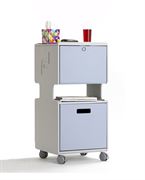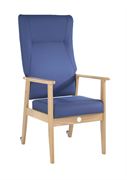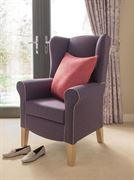Moving from the comfort of home into an unfamiliar care home can be unnerving. Therefore, it’s imperative to create a warm, welcoming environment to make the transition smooth and non-disruptive.
The bedroom is one of the most important rooms in your care home, the place where you can go to relax and recover from the stresses of the day. It needs to feel safe. This is even more so for a person with dementia, who is more likely to face struggles and upsets in their everyday activities and who may have complex needs. They serve as a resident's private space, where they can rest and relax. The design, layout, and atmosphere of the bedroom can greatly affect the resident's physical and emotional well-being.
Bedrooms should include safety features to account for the symptoms of dementia. A dementia-friendly bedroom should be easy to navigate and reduce the risks of accidents for people suffering these symptoms.
We have put together some important issues to consider when refurbishing your bedrooms.
Colours
The use of contrasting colours for your walls, floor, and furniture ensures that edges are clearly distinct. This is because residents will have difficulty with vision and perception. Patterns can cause distress and confusion, therefore should be avoided. As the bedroom should be a calm and relaxing place, colours should not be too garish either.
Flooring
Even in locations other than the obvious ones like the kitchens and bathroom, non-slip flooring might be useful for residents who are unstable on their feet. To guard against this the flooring should be painted in simple, matte colours. Surfaces with patterns or shine could be confusing. A person with dementia may attempt to pick up imaginary objects or avoid imaginary puddles, which increases the likelihood of falling.
Bed
As with all furniture, the bed needs to be clearly defined, with contrasting linen to the walls and floor. Place the bed on a direct line to the door and bathroom with a clear path between them. This will make it easy to travel from one to the other. Padded headboards can be safer. Although placing the bed against the wall may reduce the risk of falls, it is better to leave it clear on both sides to ensure its accessibility.
Rounded edges are also safer to dampen any bumps or knocks. Another way to improve safety is to use a hospital-style bed that can be raised and lowered to the most convenient level, making efforts to climb in and out much easier. Profiling beds such as our Elite Range are available to help raise someone with mobility issues from lying to a seated position.
Other furniture
Padded chairs with rounded entries increase comfort and allow greater accessibility.
Again, contrasting colours should be utilised to make the seat clearly defined. All furniture should be a different colour to the walls and floor and should not block the route to the exit or bathroom.
Many dementia sufferers have short-term memory problems, meaning that they can’t remember what they’ve placed inside their drawers and wardrobes. This can cause them to become agitated and upset, constantly opening things to see what’s in there. To reduce this behaviour, opting to incorporate an open, cut out, or partially open wardrobe and clear fronted drawers can work well.
Because dementia sufferers can have problems perceiving dimensions, it’s important that all furniture is a contrasting colour to the walls. This makes it easier for them to tell where objects are, and avoid walking into things and getting hurt.
You may also want to accessorise with an overbed table. Our range of overbed tables are designed specially so the base can easily slot underneath a bed, providing the patient with a stable surface to eat, drink or read their newspaper. They’re often adjustable so that patients can alter the height depending on whether they are sat upright or lay down. Read on to find out why overbed tables with wheels can make your life easier.
The bedroom should be spacious enough to comfortably accommodate the resident, with enough room for a bed, dresser, and other furniture. The room should also have natural lighting and be equipped with window coverings for privacy and to regulate the amount of light entering the room.
Personalisation
The bedroom should be personalised to the resident's preferences and tastes. Encouraging the resident to bring in their own belongings, such as a favourite quilt or piece of art, can help to make the room feel more like home. A small bookshelf can also be incorporated for the resident to store books, magazines, or other items.
Small, sentimental items can help the bedroom feel much cosier because it should be a comfortable space. These could contain pictures, throw pillows and blankets, a perfume bottle, or even a hairbrush. More conventional décor may be viewed as more calming because people with dementia tend to favour familiar environments. Modern architecture and technology could be strange or disorienting to them.
Bathroom access
If someone needs to use the bathroom in the middle of the night, they need a clear path to go there, especially right when they wake up because any disorientation may be amplified. That entails adequate illumination, labelling, and a clear path. A commode may be a suitable substitute for the toilet in certain circumstances, but only if the user is capable of using it. For those who have dementia, toileting is a crucial consideration.
Mirrors
Residents with dementia lose the ability to recognise their own reflections, so it’s important that mirrors can be hidden. For this reason, fold away mirrors are a good option. As for windows, it’s a good idea to have blinds in place to prevent reflections from scaring residents.
Photographs and Prints
Photos displayed in the bedroom will inspire people to exchange memories and stories. Hanging pictures of friends, family, holidays, and special occasions is a wonderful way to give the space a personal touch and will help them feel connected to their loved ones.
Take themes from home
Copying the layout from your own home is a fantastic way to make the new room feel comfortable and familiar.
Comfort
Comfort is also a crucial aspect of a good care home bedroom. The room should be designed to promote feelings of privacy and homeliness for the resident. Personal photographs and mementos can be hung on the walls, and comfortable and cosy bedding, such as a soft blanket or fluffy pillow, can be provided. A small table or desk can also be placed in the room for the resident to engage in activities such as writing letters or doing puzzles.
Atmosphere
Another important aspect of a care home bedroom is its atmosphere. The use of warm and inviting colours on the walls, such as soft blues or yellows, can have a positive impact on the resident's emotional well-being. Curtains or window treatments can also be used to add colour and texture to the room. The incorporation of plants or flowers can bring a touch of nature into the room, which can be soothing and calming for the resident.
Conclusion
A good care home bedroom should have several key characteristics to ensure the comfort, safety, and well-being of its residents.
Bedrooms in care homes play a vital role in the physical and emotional well-being of residents. A good care home bedroom should be clean, well-maintained, and comfortable, with safety features incorporated to prevent accidents. The room should also be designed to promote feelings of privacy and homeliness, and should be personalized to the resident's preferences and tastes. By taking into consideration all these aspects, care homes can create a more homely and comfortable environment for their residents.
It's also important to remember that the bedroom is not the only space in care home, common areas, dining rooms, and bathrooms should also be designed with the resident's comfort and well-being in mind.
Renray Healthcare are not just experts in designing safe, secure environments for people with dementia, but ensuring those environments are also comfortable and stylish. Our experience proves that the realities of creating a dementia-friendly bedroom do not mean you have to abandon aesthetics.


















